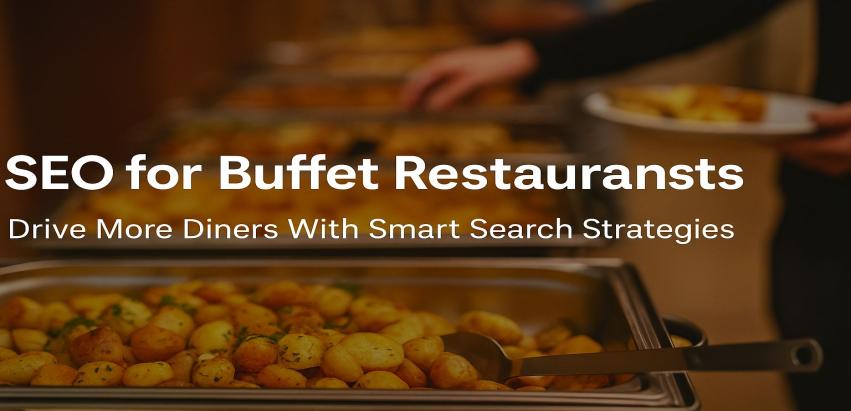

Buffet restaurants have a charm of their own. The “all-you-can-eat” appeal attracts families, college groups, office colleagues, and even tourists who are curious to try a wide spread in one go. But here’s the reality—buffet restaurants often compete head-to-head with fast food chains, casual dining, and even luxury dining outlets. So how do you stand out when hungry customers type “buffet near me” into their phones? The answer lies in smart, consistent Restaurant SEO.
Search engines are where decisions start. A diner might scroll through Instagram reels for inspiration, but when it comes to making a choice, Google is where the final decision happens. If your buffet restaurant isn’t showing up in those moments, you’re losing business to competitors.
This guide explores how buffet restaurants can use SEO to fill more seats, strengthen brand recognition, and create repeat business—all without relying on expensive ad campaigns alone.
Unlike regular à la carte restaurants, buffets thrive on volume and turnover. That means your SEO strategy needs to address high-traffic search terms and capture local visibility at scale.
Without SEO, you’re relying on word-of-mouth or expensive ads. With SEO, you’re building long-term visibility that keeps working even when you’re not spending on campaigns.
Not all buffet diners are the same. SEO only works if you match your strategy to why people are searching.
Notice the language? People are goal-oriented. They’re not just looking for food—they’re solving a problem (cheap, quick, family-friendly, luxurious). A good SEO strategy ensures your website reflects these specific search intents.
When people search for buffets, they’re almost always looking for something nearby. If your restaurant doesn’t show up in local results, you’re basically invisible to those hungry customers.
Your GBP listing is often the first impression diners get. Make it count:
People rarely stop at Google alone. They’ll check platforms like Yelp, Zomato, TripAdvisor, or OpenTable before deciding. Having consistent listings across these sites builds trust and sends strong local signals to search engines.
For buffet restaurants, reviews can make or break the deal. Guests often comment on variety, freshness, and whether the spread felt worth the price. Encourage satisfied customers to leave reviews and, if possible, mention these key points. A few well-placed phrases like “value for money buffet” or “great variety for families” can go a long way in influencing future diners.
Your website is the core of your online presence, and strong on-page SEO is what helps buffet-related searches turn into bookings. Here’s what to focus on:
Don’t stop at the obvious “buffet near me.” Target long-tail searches that show intent:
Long-tail terms are less competitive and tend to bring in diners who are ready to book.
Avoid hiding buffet details under a generic “Menu” tab. Instead, build landing pages for each major offering, such as:
Each page should target its own keyword set, include clear calls-to-action (like “Reserve Now”), and be linked internally from your homepage and navigation menu.
Structure matters. Use descriptive H1, H2, and H3 tags with buffet-related keywords. Example:
This helps Google understand your page while keeping the copy inviting for readers.
Photos and videos of buffet spreads, live counters, and interiors can boost engagement. Don’t forget alt text with buffet keywords, e.g., “Seafood buffet spread in [City].”
Structured data makes your results pop in search:
Link buffet landing pages back to your main Restaurant SEO pillar and related posts (like “family restaurants SEO” or “holiday dining SEO”). Add CTAs like “Reserve Your Table Today” to turn visits into bookings.
Content doesn’t just attract readers—it attracts diners.
Showcase your chefs preparing live counters, or explain how you source ingredients for freshness. These stories humanize your brand and help SEO by building unique content.
Buffet searches are highly mobile. Imagine someone leaving the office and searching “buffet dinner near me”—if your site doesn’t load fast, they’ll bounce.
SEO isn’t isolated. Your buffet’s social presence boosts search visibility.
You can’t improve what you don’t measure.
Organic traffic to buffet landing pages
Local pack rankings for “buffet near me”
Click-to-call conversions
Review sentiment over time
A buffet restaurant in Chicago optimized for “Sunday brunch buffet Chicago” with a dedicated landing page, updated Google Business Profile, and local backlinks. Within 4 months, they ranked in the top 3, increasing weekend bookings by 40%.
Running a buffet is already a full-time hustle—keeping SEO consistent often gets neglected. Agencies step in with:
By outsourcing seo services, restaurant owners save time and get measurable results.
Buffet restaurants depend on foot traffic and volume, but in today’s market, foot traffic starts with Google searches. A thoughtful SEO strategy—built around local optimization, niche content, structured data, and customer intent—helps buffet restaurants stay ahead of competitors and consistently bring more diners through the door.
Whether you’re running a small-town buffet or a large city chain, SEO isn’t optional anymore. It’s the steady stream that keeps your dining hall full.
Author
Aarti Patel
Founder of Aarmusmarketing.com, is a Social Media Expert, Creative Director, and Fashion Design graduate. Her passions encompass blog writing, styling, and exploring new destinations. With an innate flair for visual storytelling, Aarti brings a fresh perspective to every endeavor, infusing her work with a blend of creativity and strategic insight.